 Austria
is known by German speaking people as "Österreich", which originally meant "East
of the Reich or Empire". The Empire in this case, was the "Holy Roman Empire".
Austria
is known by German speaking people as "Österreich", which originally meant "East
of the Reich or Empire". The Empire in this case, was the "Holy Roman Empire". The House of Habsburg seized Austria in 1282 and ruled, without a break until 1918. During this reign, the Austrian Empire extended over Czecho-Slovakia, Hungary, part of Russia, Poland, Rumania, Yugoslavia and a smaller part of Italy.
The Austrian Empire period consists of two parts:
- the original Empire, which lasted from 1804 to 1867, and was founded by the Habsburg monarch, Holy Roman Emperor Francis II, who became Francis I of Austria, as a state comprising his personal lands, within and outside of the former Holy Roman Empire
- The Empire of Austria-Hungary, which lasted from 1867 to 1918, and was a monarchical union with the Kingdom of Hungary. The Habsburg monarch, Emperor Franz Josef I reigned simultaneously as the Emperor of Austria and as the King of Hungary.
The Austro-Hungarian Empire was dissolved by the Treaty of Versailles, after the end of World War I, and all of its possessions were broken up into independent countries.
The postage stamp issues of Austria began on June 1, 1850 with a series of imperforate typographed stamps featuring the coat of arms. At first they were printed on a rough hand-made paper, but after 1854 a smooth machine-made paper was used instead.
Issues between 1858 and 1861 used a profile of Emperor Franz Josef, then switched back to the coat of arms, in an oval frame.
The Austrian Empire Breaks Up
1866 was a bad year for the Austrian Empire and really the start of the beginning of the end. Prussia and Austria went to war over the Duchies of Schleswig-Holstein, which they had managed jointly, since 1864. Prussia coveted Holstein in order to dig what would become the Kiel Canal for strategic purposes. Prussia defeated the Austrians at Königratz. At the peace conference, Austria also had to surrender her Italian territories to the newly formed state of Italy.
Because of the defeat, Emperor Franz Joseph was forced to give Hungary an even say in the government of the Empire.Thus the Emperor of Austria also became King of Hungary and the new dual monarchy became known as "Austria-Hungary".
F. Josef profiles reappeared on stamps in 1867, as a side-effect of the establishment of the Austro-Hungarian Empire (at this point Hungary began issuing its own stamps), and continued until 1907, with various changes, including a change of monetary system in 1899 - from 60 kreuzer to the gulden to 100 heller to the krone.
1899 also saw the appearance of varnish bars, as diagonal shiny yellowish strips applied to the stamp paper before printing, intended to prevent cleaning and reuse of stamps. The experiment was abandoned with the 1908 issue.
In 1908, Austria issued a series of large pictorial stamps to commemorate the 60th year of F. Josef's reign, depicting previous emperors, F. Josef at various ages, Schönbrunn Palace, and the Hofburg. The designs were reused in 1910 for a Birthday Jubilee issue celebrating Josef's 80th birthday, the dates "1830" and "1910" being added at top and bottom.
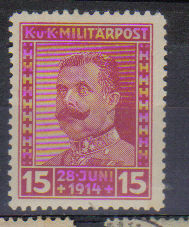 |
| Source |
The 'War to End all Wars' claimed millions of victims all over the world. It caused the death of 8 million people and the collapse of 3 Empires: those of Austria-Hungary, Germany and Russia.
A series in 1916 depicted Franz Josef, the Austrian crown, and the coat of arms, and between 1917 and 1919 Emperor Charles I briefly made an appearance on stamps before the republic was established.
Stamp-Collecting-World has a fantastic series of pages discussing the stamps of the Austrian Empire in Europe and further afield:
The general postage stamps current in Austria were originally issued as a special series to mark the sixtieth year of the Emperor's reign (1908).
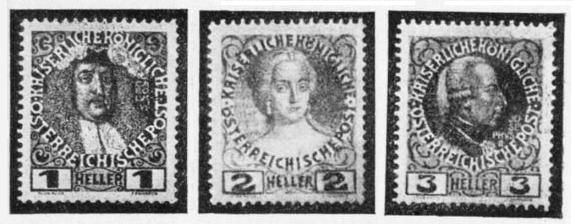
Slightly modified, they were re-issued for the celebration of his eightieth birthday (1910). The illustrations show the original issue of 1908 as still current. The portraits are copied from paintings in the Royal palaces, and the subjects are: 1 heller (Charles VI.), 2 heller (Maria Theresa), 3 heller (Joseph II.), 6 heller (Leopold II.), 12 heller (Francis I.), 20 heller (Ferdinand).
The 30 heller shows him at the time of his accession in 1848, the 35 heller a portrait painted thirty years later, 1878; the 50 heller shows him in the uniform of a Field Marshal, and on the 1 krone he figures with the insignia of the Order of the Golden Fleece. Contemporary portraits appear on the 5, 10, and 25 heller, and a particularly fine portrait stamp of large size is the 10 kronen printed in deep brown, blue and ochre.


The 2 and 5 kronen stamps respectively present views of the Imperial palaces Schönbrunn and Hofburg.
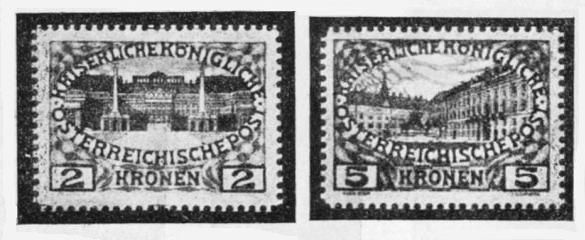
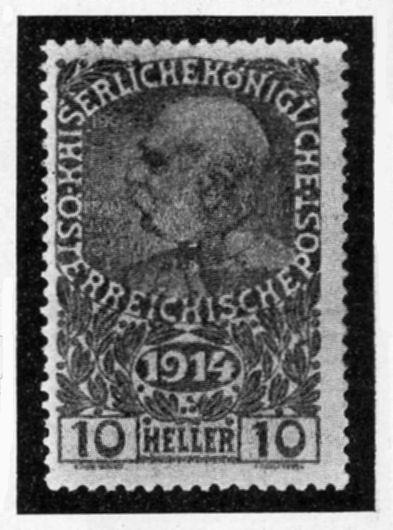 On October 4, 1914, two stamps were issued in Austria of a war charity postal character, selling for 2 heller more than the face value, the extra 2 heller going to the fund for the widows and orphans of Austrian soldiers killed in the war. The designs are adapted from the ordinary 5 and 10 heller stamps by a lengthening of the stamps for the addition of the date 1914 (Fig. 258). These although paying postage to the value of 5 and 10 heller, sell at 7 and 12 heller respectively.
On October 4, 1914, two stamps were issued in Austria of a war charity postal character, selling for 2 heller more than the face value, the extra 2 heller going to the fund for the widows and orphans of Austrian soldiers killed in the war. The designs are adapted from the ordinary 5 and 10 heller stamps by a lengthening of the stamps for the addition of the date 1914 (Fig. 258). These although paying postage to the value of 5 and 10 heller, sell at 7 and 12 heller respectively.
Includes edited excerpts from The Project Gutenberg EBook of The Postage Stamp in War, by Fred. J.
Melville
A wonderful website illustrating Austrian history through its stamps.
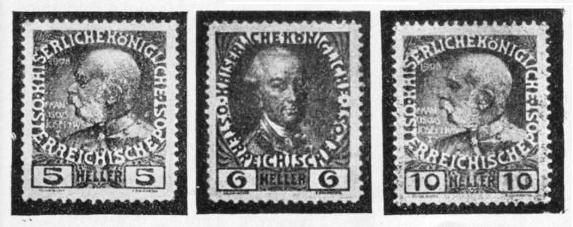

No comments:
Post a Comment